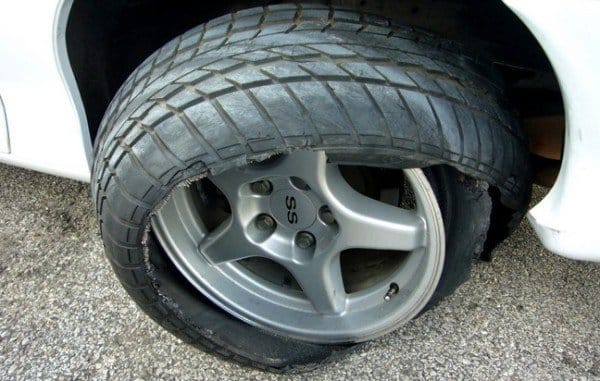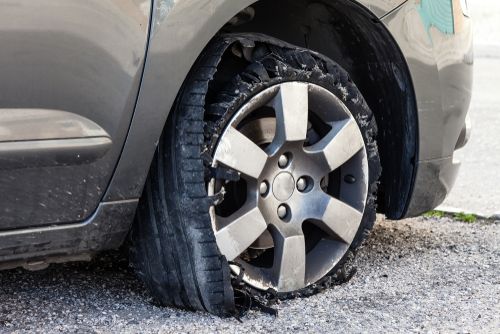How to control EV from rolling in case of tire burst.
Car tires play a significant role in the functioning of your car. The four tires at the end of your car’s axles are the only entities maintaining contact between your vehicle and the road surface.


Car tires play a significant role in the functioning of your car. The four tires at the end of your car’s axles are the only entities maintaining contact between your vehicle and the road surface. Now imagine a harrowing situation wherein you are driving at a steady speed, and the tire explodes. The next thing you know, you are completely out of control, letting your panic take over, and nobody knows if you’ll safely veer off the road or straight into oncoming traffic. It isn’t a fictitious situation and is possible if you come face to face with a tire burst. A tire burst occurs due to various reasons and has a very high potential of leading to catastrophic accidents.
What causes a tire to burst?
A tire burst occurs due to the rapid loss of pressurized air from the tire. When the structural integrity of the tire is compromised, it is unable to hold all that air inside. The pressurized air escapes by tearing through the tire rapidly causing an explosion and severe damage to the tire surface. Let’s look at the reasons why this phenomenon could occur.
i) Direct Impact
Sadly we all already know is that our country’s road conditions are pretty pathetic. Though with practice, we have trained ourselves and our reactions to avoid obstacles, bumps, and potholes on the road, sometimes, they are just unavoidable. When you hit such an unavoidable object on the road, there is a high possibility that the resulting impact could slash the tire surface at some point. This slash is an open invitation for the pressurized air to escape out, thus leading to a tire burst.
ii) High Temperatures
Heat is an enemy for almost all parts of your car and the tires. Excessive build-up of heat on or in your tires is a sure shot provocation for tire bursts. The temperature is directly proportional to pressure. Heat-build-up causes the air inside the tires to get hotter, pressurized, and start expanding. There is also friction between the road surface and the tire making it hotter from the outside and weakening the rubber. This heat-build is even more on a hot day. Therefore old tires plus a hot summer day equals a sure-shot recipe for tire burst.
iii) Under-Inflation
The most common cause of a tire burst is improper air pressure in the tyres. While over-inflation isn’t a concern, under-inflation is the reason behind approximately 75% of tire burst-induced accidents. Under-inflated tires suffer from excessive flexing will invariably increase your contact patch with the road. It leads to accumulation of more frictional force ,and in turn causes excessive heat build-up within the tyre. The heat build-up arising from this case is much higher than what would emerge from driving on a really hot summer day. Keep in mind the probability of a tire burst occurring from under-inflation is much higher than just a higher temperature.
iv) High Speed
Each tire available in the market has a different speed. The tire materials and construction are made to withstand speeds up to that point only. Anywhere beyond that, the tire structure will be incapable of handling the higher friction levels and giving in very quickly.
v) Overloading the Car
Overloading the car can also cause tyre burst in a similar manner. Excess weight in your vehicle will transfer all that load straight to the tires and result in flexing of the sidewalls.
How to prevent tire burst
i) Make sure your tire has the correct pressure.
Tire pressure increases with heat and decreases as temperatures reduce. So be wary of the weather conditions around you as well. Maintain the ideal pressure as mentioned in your car’s manual and everything should be fine.
ii) Never Overload Your Car.
Filling up your small hatchback with six people and individual six bags of luggage is a call for trouble. Each car is designed to carry only a certain level of weight. Stick to that limit, and you should be safe from any incidents.
iii) Choose the Tyre With the Appropriate Speed.
Different tires are designed for different speeds, therefore it is important to choose tires that fit your cars speed.
iv) Always Go For Reputed Brands.
Big brands have dedicated R&D centers where each product design is well planned and thoroughly tested before being released to product. The same will certainly not be the case with unfamiliar brands or imitators. Hence, it is best if you stay away from them. The choice is in your hands, a few bucks of savings or your life.
v) Do not slam on the brake pedal.
Hard braking is the worst thing you can do. It will further imbalance the vehicle and throw it out of control.
vi) Don’t abruptly take your foot off the accelerator.
Remove your foot from the accelerator slowly and gradually. The deceleration force from a blown tire is so strong that your car will anyway slow down rapidly. If you have engaged in cruise control, be sure to disengage it immediately.
vii)Try your best to keep the vehicle pointed straight.
Cornering or turning with a blown tire will greatly upset the car’s composure. If your car is pulling to one side, you might need to pull the steering in the opposite direction to keep it going straight. It is critical, else you risk drifting into the road divider or worse still, the opposite lane.
viii) Do not attempt to over-correct
The key is to maintain the vehicle’s stability. A sharp yank of the steering wheel can result in a rollover. Even when you have gained control and are slowly moving to a safe parking spot, do so with the mildest steering inputs possible.
Source:
i) S.Sriram (2022) The Dangers of Tyre Burst: Why It Happens and How Can You Prevent It From Happening.




